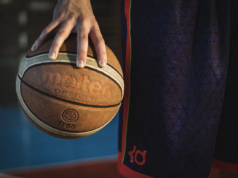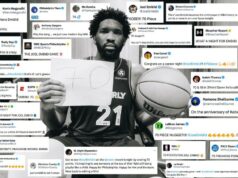Through 20 games of the NBA season, the San Antonio Spurs have the second best record in the NBA (16-4), and they’re on pace to win 65 games this season, with a roster filled with seven new players.
So, how is the team doing on each side of the floor? We’ll go into detail section by section. You can read Volume 1 of how the Spurs were doing after their first 10 games of the season here.
Section I. Scoring
| Category | Volume 1 | Rank | Currently | Rank |
| Offensive Rating (Points Per 100 Possessions) | 107.7 PP/100 | 6th | 108.6 PP/100 | 6th |
| Field Goal % | 44.7% | 13th | 46.1% | 6th |
| 3-Point % | 38.6% | 2nd | 40% | 1st |
| Points in Paint | 36.2 points | 29th | 34.3 points | 29th |
| Bench Points Per Game | 37.6 points | 9th | 36.0 points | 11th |
| Transition Points | 11.9 points | 20th | 11.0 points | 24th |
The Spurs’ scoring rose just a bit from 107.7 Points Per 100 possessions to 108.6 PP/100 in the last 10 games, but overall, they still have a Top-10 offensive unit. In 125 minutes, the Spurs’ starting five of Tony Parker, Danny Green, Kawhi Leonard, LaMarcus Aldridge and Paul Gasol haven’t quite separated themselves (+6.5 PP/100), and have a Net Rating of the overall team (+6.1 PP/100).
As you can see from the lineup numbers, the Spurs with Tim Duncan last season played much better defense, but their offense wasn’t quite at the mark of this year’s team, even though Duncan’s starting five played at a slightly faster pace.
2017 Starting 5 (with Gasol): OFFENSE 108.1 PP/100 – DEFENSE 101.6 PP/100 = +6.5 Net Rating (Pace 92.69).
2016 Starting 5 (with Duncan): OFFENSE 104.7 PP/100 – DEFENSE 96.1 PP/100 = +8.6 Net Rating (Pace 93.67).
The Spurs’ bench or ‘juice’ unit is excelling through 1.5 months of the season, as the lineup of Patty Mills, Manu Ginobili, Jonathon Simmons, David Lee and Dewayne Dedmon are outscoring teams by 45.8 PP/100. The bench unit is where you see the motion fast paced offense that was the foundation of the Spurs during their ‘Beautiful game’ era. The bench unit plays at a very fast pace (104.56 possessions per 48 minutes) and they’re scoring like the Golden State Warriors with an offensive rating of 114.7 PP/100, while their defense is holding teams to 68.9 PP/100 in 33 total minutes together. Two notes though on the bench – 1) they mostly play at the end of the first quarter and end of the third quarter, and they’re playing against other teams’ second units, so they don’t have to go against the elite players for most of their minutes together. 2) Due to the starters getting rest games or early season injuries to players, the bench unit’s sample size is still relatively low at only 33 minutes.
Mills has had some eye popping games where’s he’s gotten hot and been a lethal scorer for the team early on this season. While most fans might want him to start, it’s important to note that the data (only 24 minutes), says that’s not such a good idea, as the starting five with Mills is getting outscored by 19.4 PP/100, and while the offense doesn’t click well with him running the show (99.4 PP/100), the defense suffers even more, allowing teams to score 118.8 PP/100. Again, the sample size is small, but in the minutes Mills has played with the starters, the eye test shows the other four players don’t seem as comfortable in getting to their spots and the offense tends to not flow as well, as compared to Parker running the show.
The Spurs have used a few lineups with Aldridge at the 5, and most aren’t doing so well, except one in particular. In 16 minutes together, the lineup of Mills, Green, Leonard, Lee and Aldridge are outscoring teams by 20.9 PP/100. While the pace is still slow for this unit, having four players who can space the floor and Lee who can roll or crash the glass has been a solid combination. That unit isn’t particularly good on defense (107.2 PP/100), but their offense just obliterates teams (128.1 PP/100).
On the Spurs’ 3-point shooting, they’re the top shooting team in the NBA, as the data above shows. Nine of the Spurs’ core players take over 1.0 threes per game, and all of them, except, Simmons (1.1 attempts, 19.0% 3PT shooting), shoot above league average (35.1%) from three. But, as the table below will show, the Spurs only generate 25.5% of their points from 3-point range, because they’re one of the lowest volume 3-point shooting teams in the league (27th in 3-Point attempts at 21.9 per game).
Where do the Spurs’ points come from?
| Area | Volume 1 | Rank | Percentage of Points | Rank |
| Points in the Paint | 35.5% | 29th | 33.3% | 30th |
| 3-Pointers | 23.8% | 20th | 25.5% | 17th |
| Free Throws | 20.4% | 2nd | 19.4% | 3rd |
| Mid-Range | 20.2% | 4th | 21.8% | 1st |
The Spurs are the now the top team in generating points from the mid-range area, and this is no surprise with Leonard’s ability to shoot from mid-range, and Aldridge and Gasol’s jump shooting ability. Together, Leonard, Aldridge and Gasol get to the free throw line 13.9 of the team’s 24.4 times per game. This will be key later in close games and the playoffs, as elite teams contending for titles need aggressive players who can get to the free throw line when outside shots are constantly being contested.
The one interesting area to look at is how the Spurs aren’t generating many points from the closest spot to the rim – the paint. Looking at last season’s squad, the Spurs got 42.1% of their points from the paint (ranked 16th), and while they weren’t elite in scoring in the paint, they were average, not last in the league, like this season’s team.
So, I went through and looked at the core Spurs players from this season and last season, and while the numbers are similar for most players that are on both squads, three players that are scoring much less from the paint this season are Simmons, Aldridge and Leonard.
Percentage of Points in Paint
Simmons: This Season: 47.8%, Last season: 56.2%
Aldridge: TS 33.5%, LS 46.3%
Leonard: TS 24.3%, LS 33.5%
That’s a decrease of about 10 percentage points those three players from the paint this season. This could be attributed to less drives per game, Aldridge and Leonard’s reliance more-so of using the outside shot, and the fact that Leonard and Aldridge get to the free throw line a lot more this season, which means they’re getting fouled more often when attacking. For Simmons, with this being his second season, the scouting report is out on his struggles in shooting, so teams know they can back off him and play to prevent his drives.
In the times the Spurs’ offense has gone stagnate and they go several minutes without score baskets, observations show they try too often to rely on mid-range or 3-point looks, rather than posting up and spacing out. With new core pieces, this may still be something the team is learning – when to try to get more looks in the paint when shots aren’t falling in games.
Using the NBA’s Usage Percentages for players, I created the chart below to show the Spurs’ 11 core players and how much of the team’s possessions they’ve been using when on the floor.

When looking at their top-3 playmakers (Leonard, Aldridge, Gasol), I was trying to figure out which was the last title team who relied upon a wing and two bigs as their top-3 playmakers, and the most obvious comparison is the 2009 and 2010 championship Los Angeles Lakers teams, which featured Kobe Bryant, Gasol and Andrew Bynum as their big-3 during those years. Those Lakers ran the triangle offense, which operated at a similar pace to today’s Spurs, and though the Spurs’ big 3 mainly get their looks out of motion sets first, in the end, most possessions are being used to have Leonard, Aldridge or Gasol, create or score for their team, like Bryant, Gasol and Bynum used to do for the Lakers. The usage numbers are very similar between the three, as you’ll see below. These Spurs are actually relying more so on their second option (Aldridge) than those Lakers did on their number two players in 2009 and 2010.

Where do the Spurs rank in Offense thus far?

Best: Golden State Warriors 114.7 PP/100
Spurs: 108.6 PP/100 – 6th
League Average: Oklahoma City Thunder 103.7 PP/100
Worst: Orlando Magic 96.8 PP/100
Section II. Ball Movement
| Category | Volume 1 | Rank | Currently | Rank |
| Assists | 21.1 assists | 17th | 22.7 assists | 9th |
| Turnovers | 11.5 turnovers | 3rd Best | 12.8 turnovers | 7th |
| Assisted Made Baskets | 57.8% | 14th | 61.2% | 6th |
| Unassisted Made Baskets | 42.2% | 14th | 38.8% | 25th |
| Passes Per Game | 311.7 Passes | 9th | 318.8 Passes | 5th |
| Secondary Assists Per Game | 5.4 assists | 14th | 6.1 assists | 3rd |
| Points Created By Assists | 50.7 points | 16th | 54.3 points | 9th |
| Touches Per Game | 427.3 touches | 11th | 436.0 touches | 8th |
| Bench Assists Per Game | 8.3 assists | 8th | 9.4 assists | 5th |
While the Spurs have added about one assist to their average after the first 10 games of the season, they’re starting to become a machine in moving the ball, as they’re assisting in almost evert category at a Top-10 level. The difference between these Spurs and those of the past is that their pace is a lot slower today, because as mentioned above, and as the usage chart displayed, most of their shots are created out of looks generated for Leonard, Aldridge and Gasol. Both Gasol and Aldridge pick-and-pop which requires a pick-and-roll offense, or they can both post-up, which uses a slower post and space out offense. Leonard, can also run the pick-and-roll, post-up, or he can face up and attack or shoot from the mid-range. So, with a slower pace, the team might not look like it’s moving the ball as much, but as the numbers above show, this offense is operating like a Top-10 ball moment machine.
Section III. Defense
| Category | Volume 1 | Rank | Currently | Rank |
| Defensive Rating (Points Per 100 Possessions) | 100.6 PP/100 | 7th | 102.5 PP/100 | 12th |
| Opponent Field Goal Attempts | 81.1 FGA | 6th | 82.2 FGA | 5th |
| Opponent FG% | 43.8% | 10th | 45.3% | 18th |
| Opponent 3-Point Field Goal Attempts | 27.7 3PT-FGA | 23rd | 24.9 3PT-FGA | 7th |
| Opponent 3-Point FG% | 32.1% | 7th | 35.0% | 15th |
| Opponent Corner 3-Point % | 28.6% | 4th | 34.0% | 3rd |
| Opponent Corner 3-Pointers | 7.7 FGA | 28th | 7.1 FGA | 26th |
| Opponent Above the Break 3-Pointers | 19.3 FGA | 19th | 17.4 FGA | 2nd |
| Opponent Above the Break 3PT% | 34.7% | 21st | 36.2% | 23rd |
| Opponent Free Throw Attempts | 21.7 FTA | 11th | 19.8 FTA | 6th |
| Opponent FG% in Restricted Area | 58.8% | 11th | 59.1% | 9th |
| Opponent Shots in Restricted Area | 24.3 FGA | 4th | 25.4 FGA | 6th |
| Force Mid-Range Shots | 18.1 FGA | 23rd | 20.0 FGA | 15th |
| Defensive Rebounds | 33.9 Reb | 15th | 32.6 Reb | 22nd |
| Limit Opponent Offensive Rebounds | 7.8 Rebounds | 3rd | 9.1 Rebounds | 3rd |
| Opponent Transition Points | 12.4 PPG | 12th | 12.5 PPG | 17th |
With their defensive rating, the Spurs slipped a bit after their first 10 games of the season, as they started allowing two more points per 100 possessions now. However, across the league, the difference from average to league best is a very close margin. For example, the Los Angeles Clippers are the top defensive team in holding teams to 98.9 PP/100. That means the Spurs are just 3.6 PP/100 behind the Clips, the they’re only 1.1 PP/100 better than the league average defense of the Dallas Mavericks. More games will need to be played before separation is created and we can really see who the elite defensive teams are in the league.
As the table above shows, the Spurs are slowly becoming a solid defensive team in most important areas, like limiting shots at the rim, the 3-point line, the free throw line, and they’re forcing more teams to start taking non-paint twos. The defensive rebounding might look like a concern initially at 32.6 boards per game, but that more-so has to do with the fact that the Spurs force their opponents to play at a slower pace, which means opposing teams get less shots against San Antonio, which leads to less opportunities to grab defensive boards for the Spurs on misses. IF the Spurs were having trouble stopping offensive boards by opponents, then there would be cause for concern for the rebounding department, but through 20 games, there’s not a big rebounding concern.
While the Spurs are ranked 7th in limiting opponent 3-pointers, one area to watch for their defense is how they’re guarding the left wing area of the above the break 3-pointer, as the shot chart below shows.

In 20 games, teams are shooting 42.3% from the left wing three, which is 6.4% above league average.
I went back and watched a majority of those attempts from the opponents, and the most common mistakes the Spurs are making are:
Over-helping from the wings – too often, the Spurs’ perimeter players are being caught helping too far in the paint on post-ups or driving action, so, when the ball is kicked out or swung, the Spurs’ perimeter defender has either lost sight of his shooter or he’s too late to contest the shot.
Lack of communication, support from bigs – The other area where the Spurs have had trouble is getting help from their big men in contesting threes. In transition, the bigs have had communication breakdowns, so shooters are left unassigned when crossmatches happen, or, when screens are set by opposing bigs, the Spurs’ big men (mainly Gasol and Aldridge), are going far under screens instead of helping to hedge out to help the wing defender buy enough time to recover onto the shooter. This is allowing the shooters to come off the screens with open looks, but, it might also stem from the bigs having instructions not to step out on certain shooters from the outside, and instead, continue to protect the paint.
The last area where the Spurs’ bigs are having trouble is on switches and rotations. If the bigs switch onto an outside shooter, they might stay with them for a bit, but as soon as the lane is being penetrated, that big might use their natural instincts to run toward the rim and try to contest a shot, which means they’ve lost the outside shooter. On rotations, too often the big is late in the next rotation, which leaves one of the outside players having to guard two players at once, and the pass is made too quickly for the outside player to challenge one of those open shooters.
The breakdowns on communication on defense are to be expected, as the Spurs are implementing almost an entire new cast of big men, outside of Aldridge. As the bigs get more minutes in different lineups with the wings, more communication and chemistry will continue to be developed, and those rotations should start to become tighter with more experience on the floor together.
Where do the Spurs rank in Defense thus far?

Best: Los Angeles Clippers 98.9 PP/100
Spurs: 102.5 PP/100 – 12th
League Average: Dallas Mavericks 103.6 PP/100
Worst: Portland Trail Blazers 109.6 PP/100
Section IV. Record Vs. Elite teams (.600 Winning Percentage)
| Category | Currently |
| Winning Percentage | 60% |
| Record | 3-2 |
The Spurs are currently 3-2 against teams with records of .600 or above.
Golden State Warriors: 1-0
Los Angeles Clippers: 0-1
Houston Rockets: 1-1
Boston Celtics: 1-0
Total: 3-2
Section V. The Next 10
The Spurs will play 10 games in the next 19 days from 12/05 to 12/23. During that stretch, the team will have three back-to-back sets, and they’ll face three elite teams – the Celtics (12-8), Rockets (13-7) and Clippers (16-5).
Data gathered from NBA.com/stats






